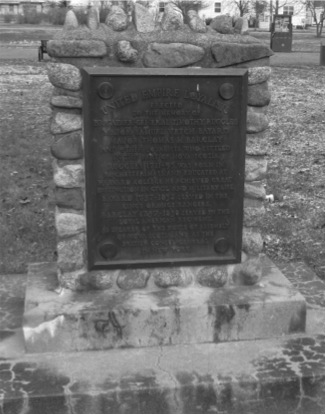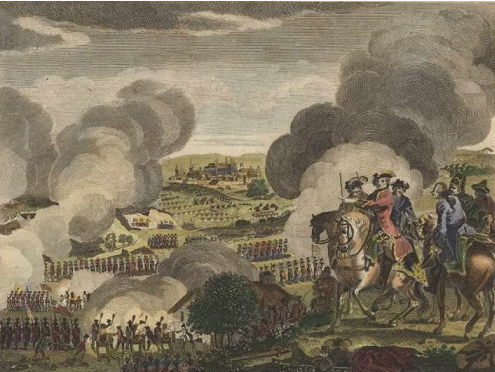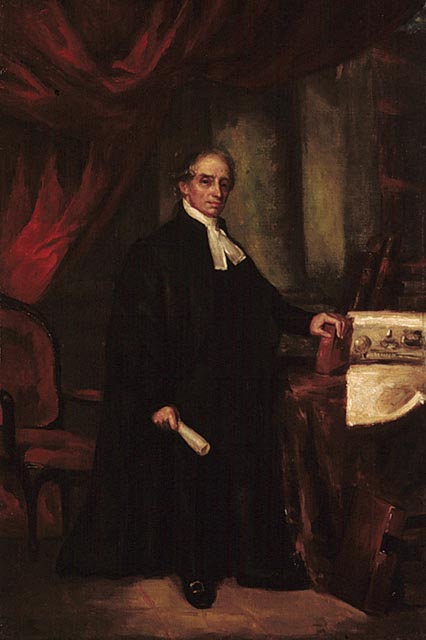|
Samuel Bayard
Lieutenant Colonel Samuel Vetch Bayard (born 1757, New York – d. 28 May 1832 Wilmot, Nova Scotia) was a Loyalist military officer in the American Revolution who served in the King's Orange Rangers (KOR). He is the son of William Bayard who founded the KOR. He was the great-grandson of Governor Samuel Vetch and was the father of Robert Bayard. Career In March 1778, Lt. Col. Samuel Bayard was charged with murdering one of his own officers in the ranger unit. Bayard was tried and found guilty of manslaughter in October, and sentenced to be suspended for three months and then removed from his command. This sentence was overturned on a technicality by the Judge Advocate General, but probably played a role in Bayard's subsequent difficulties in retaining his command. On November 17, 1778 the KOR arrived by sea at Halifax, Nova Scotia. The reason for the transfer was probably to stem the rate of desertion by relocating the men to a place much farther away from their homes. The KOR ... [...More Info...] [...Related Items...] OR: [Wikipedia] [Google] [Baidu] |
Port Medway, Nova Scotia
Port Medway is a community in the Canadian province of Nova Scotia, located in the Region of Queens Municipality The Region of Queens Municipality is a regional municipality in southwestern Nova Scotia, Canada. It is the northern gateway of the UNESCO Southwest Nova Biosphere Reserve, a centre of outdoor activities. Campgrounds at Kejimukujik National Park a .... {{coord, 44, 7, 33, N, 64, 34, 26, W, name=Port Medway, Nova Scotia, display=title, region:CA-NS_scale:100000 History Was early settled by United Empire Loyalists via Land Petitions/Memorials in the 1780s per N.S. Archives Because of its deep harbor, the town originally housed a significant wooden shipbuilding industry owned by the Wylde family. At its most prosperous, over 5,000 inhabitants lived and worked there. When the industry disappeared the population dwindled to a few hundred residents. After the historic lighthouse was decommissioned, it was purchased by Queens County and restored in 2002. More details oP ... [...More Info...] [...Related Items...] OR: [Wikipedia] [Google] [Baidu] |
1757 Births
Events January–March * January 2 – Seven Years' War: The British Army, under the command of Robert Clive, captures Calcutta, India. * January 5 – Robert-François Damiens makes an unsuccessful assassination attempt on Louis XV of France, who is slightly wounded by the knife attack. On March 28 Damiens is publicly executed by burning and dismemberment, the last person in France to suffer this punishment. * January 12 – Koca Ragıp Pasha becomes the new Grand Vizier of the Ottoman Empire, and administers the office for seven years until his death in 1763. * February 1 – King Louis XV of France dismisses his two most influential advisers. His Secretary of State for War, the Comte d'Argenson and the Secretary of the Navy, Jean-Baptiste de Machault d'Arnouville, are both removed from office at the urging of the King's mistress, Madame de Pompadour. * February 2 – At Versailles in France, representatives of the Russian Empire an ... [...More Info...] [...Related Items...] OR: [Wikipedia] [Google] [Baidu] |
Nova Scotia In The American Revolution
The Province of Nova Scotia was heavily involved in the American Revolutionary War (1776–1783). At that time, Nova Scotia also included present-day New Brunswick until that colony was created in 1784. The Revolution had a significant impact on shaping Nova Scotia, "almost the 14th American Colony". At the beginning, there was ambivalence in Nova Scotia over whether the colony should join the Americans in the war against Britain. Largely as a result of American privateer raids on Nova Scotia villages, as the war continued, the population of Nova Scotia solidified their support for the British. Nova Scotians were also influenced to remain loyal to Britain by the presence of British military units, judicial prosecution by the Nova Scotia Governors and the efforts of Reverend Henry Alline. Context In Nova Scotia a number of former New England residents objected to the Stamp Act 1765, but recent British immigrants and London-oriented business interests based in Halifax, the provin ... [...More Info...] [...Related Items...] OR: [Wikipedia] [Google] [Baidu] |
Royal Nova Scotia Regiment
The Royal Nova Scotia Regiment (Nova Scotia Fencibles) was a battalion of infantry raised in 1793 to defend British interests in the colony of Nova Scotia during the Wars of the French Revolution. The unit was commanded by Colonel John Wentworth, the lieutenant-governor of the colony, throughout its existence. The Royal Nova Scotia Regiment (RNSR) had an undistinguished history through most of its existence, and saw very limited action, mostly in the role of marines, but did play an important role in the defense of Nova Scotia during these wars. Formation As tensions rose between the governments of Britain and Revolutionary France in early 1793, the British secretary of state for the colonies, Henry Dundas, wrote to Wentworth that the question of raising a provincial regiment for the defense of Nova Scotia was under consideration. In April, word arrived in Halifax, also from Dundas, that war had been declared, that all but 200 men of the British garrison were to be sent to t ... [...More Info...] [...Related Items...] OR: [Wikipedia] [Google] [Baidu] |
Prince Edward, Duke Of Kent And Strathearn
Prince Edward, Duke of Kent and Strathearn, (Edward Augustus; 2 November 1767 – 23 January 1820) was the fourth son and fifth child of King George III. His only legitimate child became Queen Victoria. Prince Edward was created Duke of Kent and Strathearn and Earl of Dublin on 23 April 1799''Whitehall, 23 April 1799.''The King has been pleased to grant to His Most Dearly-Beloved Son Prince Edward, and to the Heirs Male of His Royal Highness's Body lawfully begotten, the Dignities of Duke of the Kingdom of Great Britain, and of Earl of the Kingdom of Ireland, by the Names, Styles, and Titles of Duke of Kent, and of Strathern, in the Kingdom of Great Britain, and of Earl of Dublin, in the Kingdom of Ireland. and, a few weeks later, appointed a General and commander-in-chief of British forces in the Maritime Provinces of North America. On 23 March 1802, he was appointed Governor of Gibraltar and nominally retained that post until his death. The Duke was appointed Field-Marshal of ... [...More Info...] [...Related Items...] OR: [Wikipedia] [Google] [Baidu] |
Royal Nova Scotia Volunteer Regiment
The Royal Nova Scotia Volunteer Regiment, also known as the Loyal Regiment of Nova Scotia Volunteers and Loyal Nova Scotia Volunteers, from 1775-1780, the Royal Regiment of Nova Scotia Volunteers, from 1780-1783, and the Royal Nova Scotia Volunteer Regiment and Nova Scotia Volunteers, was a British Loyalist (American Revolution), Loyalist provincial battalion, of infantry, raised in 1775, to defend British interests, in the colony of Nova Scotia. The unit was commanded by Col. Francis Legge, until replaced by Col. John Parr (governor), John Parr in 1782. The Royal NS Volunteers never saw combat, but did play an important role in the defense of the colony of Nova Scotia, in the later years, of the American Revolution. Regiment formed Francis Legge was appointed the royal governor of Nova Scotia in 1773, just as troubles were brewing in the American colonies. Legge, "an earnest but highly prejudiced and therefore much disliked man" proposed to the Secretary of State on July 31, ... [...More Info...] [...Related Items...] OR: [Wikipedia] [Google] [Baidu] |
Henry Edward Fox
General Henry Edward Fox (4 March 1755 – 18 July 1811) was a British Army general who served brief spells as Governor of Minorca and Governor of Gibraltar. Family He was a son of Henry Fox, 1st Baron Holland and Lady Caroline Lennox (1723–1774), and a younger brother of the politician Charles James Fox (1749–1806). His mother's father was Charles Lennox, 2nd Duke of Richmond (1701–1750), an illegitimate grandson of King Charles II. Life He attended Westminster School before being commissioned as a cornet in the 1st dragoon guards in 1770. Soon after that he spent 1 year's leave at the military academy at Strasbourg. After his return he rose to lieutenant (1773) then captain (1774). American War of Independence In 1773 he moved to the 38th Regiment of Foot, stationed at Boston, and fought in the American War of Independence (spending 1778–79 on leave in England). By the end of the war he had risen to colonel and king's aide-de-camp, and he then moved to command the for ... [...More Info...] [...Related Items...] OR: [Wikipedia] [Google] [Baidu] |
Annapolis Valley
The Annapolis Valley is a valley and region in the Canadian province of Nova Scotia. It is located in the western part of the Nova Scotia peninsula, formed by a trough between two parallel mountain ranges along the shore of the Bay of Fundy. Statistics Canada defines the Annapolis Valley as an economic region, composed of Annapolis County, Kings County, and Hants County. Geography The valley measures approximately in length from Digby and the Annapolis Basin in the west to Wolfville and the Minas Basin in the east, spanning the counties of Digby, Annapolis and Kings. Some also include the western part of Hants County, including the towns of Hantsport and Windsor even further to the east, but geographically speaking they are part of the Avon River valley. The steep face of basaltic North Mountain shelters the valley from the adjacent Bay of Fundy and rises over in elevation near Lawrencetown. The granitic South Mountain rises to a somewhat higher elevation and shel ... [...More Info...] [...Related Items...] OR: [Wikipedia] [Google] [Baidu] |
Liberty Pole
A liberty pole is a wooden pole, or sometimes spear or lance, surmounted by a "cap of liberty", mostly of the Phrygian cap. The symbol originated in the immediate aftermath of the assassination of the Roman dictator Julius Caesar by a group of Rome's Senators in 44 BCE. Immediately after Caesar was killed the assassins, or Liberatores as they called themselves, went through the streets with their bloody weapons held up, one carrying a pileus (a kind of skullcap that identified a freed slave, not in fact a Phrygian cap) carried on the tip of a spear. This symbolized that the Roman people had been freed from the rule of Caesar, which the assassins claimed had become a tyranny because it overstepped the authority of the Senate and thus betrayed the Republic. The liberty pole was not thereafter part of the normal Roman depiction of Libertas, the Roman goddess of liberty, who is very often shown holding out a pileus, and carrying a pole or rod. Both refer to the ceremony granting f ... [...More Info...] [...Related Items...] OR: [Wikipedia] [Google] [Baidu] |
Fort Hughes (Nova Scotia)
Fort Hughes (also known as the Planters Barracks) was a fortification that was built at present-day Starr's Point, Nova Scotia during the American Revolution to protect against raids by American privateers. The fortification was named after the Governor of Nova Scotia Sir Richard Hughes, 2nd Baronet who had the fortification built on a piece of land belonging to Samuel Starr, a Planter from Norwich, Connecticut and militia officer. Three months after a privateer raid on the Cornwallis river, the Barracks was built in 1778 beside the militia parade ground at Starr's Point. 56 troops were stationed there. The King's Orange Rangers were stationed at the fortification during the Revolution. The Rangers were sent to the area, in part, to ensure that the Planters remained loyal to the King. In the spring of 1781, Major Samuel Bayard led the King's Orange Rangers from Halifax to Fort Hughes to overawe local Planters who were planning to erect a Liberty Pole and thereby break with the Kin ... [...More Info...] [...Related Items...] OR: [Wikipedia] [Google] [Baidu] |




GeorgeDawe.jpg)

_Arms.png)

